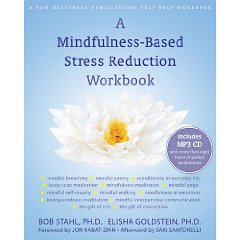
About once a year I discover a workbook that allows me to put all the steps that I learn in therapy into practice. I’ve mentioned in past blogs David Burns’s “10 Days to Self-Esteem,” and how the exercises in that workbook allowed me to recognize distorted thought patterns and practice ways of untwisting them. Two years or so ago, when I didn’t know whether or not I should have my son treated for anxiety, my therapist recommended I read “Understanding Your Child’s Puzzling Behavior,” which was very, very helpful. And now fellow blogger and mindfulness expert Elisha Goldstein has published, with co-author Bob Stahl, a comprehensive workbook–“A Mindfulness-Based Stress Reduction Workbook”— that teaches the art of mindfulness in relieving and reducing stress.
If I had to identify one quality that separates this book from the rest of the mindfulness resources in the self-help aisle, it’s that these pages are so practical and can’t help but provide the reader with plenty of “Aha!” moments. Reading through the chapters and exercises, I appreciate all the research that Goldstein and Stahl studied, material that illuminates how mindfulness exercises can alter and help shape your brain to be more optimistic and resilient. But what won my trust is that they have both been stress cases themselves at certain points in their lives, and can therefore communicate with empathetic language. They both know, on a very personal level, how stress can disable a person. Much like Kay Redfield Jamison, the famous psychologist who suffers from bipolar disorder, they speak both as expert and patient.
What, exactly, is mindfulness? Stahl and Goldstien write:
Mindfulness is about being fully aware of whatever is happening in the present moment, without filters or the lens of judgment. It can be brought to any situation. Put simply, mindfulness consists of cultivating awareness of the mind and body and living in the here and now. While mindfulness as a practice is historically rooted in ancient Buddhist meditative disciplines, it’s also a universal practice that anyone can benefit from. And indeed, being present and mindful is an important concept in many spiritual traditions, including Buddhism, Christianity, Hinduism, Islam, Judaism, and Taoism.
Today mindfulness has expanded beyond its spiritual roots and even beyond psychology and mental and emotional well-being. Physicians are prescribing training in mindfulness practice to help people deal with stress, pain, and illness….In the words of Walpola Rahula, author of the Buddhist classic “What the Buddha Taught,” “[Mindfulness] is simply observing, watching, examining. You are not a judge but a scientist.”
I understand mindfulness as forcing a bit of time and space between a situation and your reaction, or recognizing the snowball of thoughts that’s forming in your mind before it becomes too overwhelming to sort through yourself. Goldstein and Stahl quote Vicktor Frankl, psychiatrist and holocaust survivor: “Between stimulus and response there is a space. In that space is our power to choose our response. In our response lies our growth and our freedom.”
Although mindfulness techniques aren’t able to rescue me out of an acute, severe depression, if I diligently adhered to all the wisdom contained in Stahl and Goldstein’s book, and designated a time of the day to do all the exercises, I could save myself some considerable heartache and headache.
Why?
Their mindfulness exercises allow the reader to take some of the files off of her cluttered and disorganized desk because the files relate to the past or to the future, and the present tense is the only one she should worry about now. According to the authors, mindfulness is about sticking to the here and now and banishing all judgment. It’s also about breaking the job, day, or situation down … into small parts, in order to better manage it.
For example, in one of the first exercises, they suggest we list the stressful situation and rate it from a 1 (not very stressful) to a 10 (Help! I’ve fallen and can’t get up!). I started listing all the situations that bring me the most stress, most of which I assigned an 8:
- Going through my email
- Responding to requests for help (either with publishing or mental health)
- Dealing with all my medical conditions
- Eric’s work situation
- Meeting work deadlines
- Our healthcare situation and expenses
- Temper tantrums
- Doing homework with the kids
- Getting household jobs done during the weekend
- Putting the kids to bed
After I pinpointed which situations were producing the most stress, I felt a nice relief – that it’s not “my life is so stressful, I can’t take it!” but rather, “I have some stressful things going on in my life, let’s see if there are some solutions.” For example, erecting more boundaries on my email policy is probably needed. I should go back to checking emails only once or twice a day, designating a time of day, and sorting them into various categories in order of importance. Or maybe I can come up with some behavioral method that gives the kids incentive to complete their homework without my yelling bloody murder. These are modest revisions, but they could relieve a chunk of stress.
Goldstein and Stahl’s workbook uses a strong motivator for readers to learn the beneficial habit of mindfulness, and that is accountability. When you write things down and record your progress, you become accountable. Maybe that’s why my kids hate homework so much, come to think of it. So what they have done for us is set up a system by which we can challenge ourselves to better integrate our body, mind, and soul. Or at least that’s the plan.
I recommend this workbook to anyone who is stressed out … um … everyone I know.
* Click here to subscribe to Beyond Blue and click here to follow Therese on Twitter and click here to join Group Beyond Blue, a depression support group. Now stop clicking.

